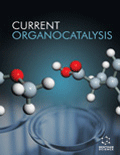-
s Supramolecular Macrostructures in the Mechanisms of Catalysis with Nickel or Iron Heteroligand Complexes
- Source: Current Organocatalysis, Volume 6, Issue 1, Jan 2019, p. 36 - 43
-
- 01 Jan 2019
Abstract
Background: The AFM-techniques have been used for the research of the role of intermolecular H-bonds and stable supramolecular nanostructures, based on effective catalysts of oxidation processes, which are also models of Ni(Fe)ARD Dioxygenases, in mechanisms of catalysis. Methods and Results: The role of Histidine and Tyrosine ligands in the mechanisms of catalysis by FeARD on model systems is discussed based on AFM and UV-Spectroscopy data. Conclusion: We first offer the new approach – method of atomic force microscopy (AFM) – to study the possibility of the formation of supramolecular nanostructures, and also for assessing of role the intermolecular hydrogen bonds (and the other intermolecular non-covalent interactions) in mechanisms of homogeneous and enzymatic catalysis with nickel and iron complexes.


